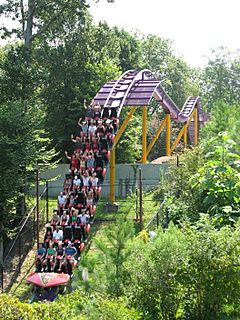Apollo's Chariot facts for kids
Quick facts for kids Apollo's Chariot |
|
|---|---|
 |
|

The first drop of Apollo's Chariot is at an angle of 65°.
|
|
| Busch Gardens Williamsburg | |
| Location | Busch Gardens Williamsburg |
| Park section | Festa Italia |
| Coordinates | 37°14′05″N 76°38′29″W / 37.23480°N 76.64130°W |
| Status | Operating |
| Soft opening date | March 27, 1999 |
| Opening date | March 30, 1999 |
| Cost | US$20 million |
| General statistics | |
| Type | Steel |
| Manufacturer | Bolliger & Mabillard |
| Designer | Werner Stengel |
| Model | Hyper Coaster |
| Track layout | Out and Back/Terrain |
| Lift/launch system | Chain lift hill |
| Height | 170 ft (52 m) |
| Drop | 210 ft (64 m) |
| Length | 4,882 ft (1,488 m) |
| Speed | 73 mph (117 km/h) |
| Inversions | 0 |
| Duration | 2:15 |
| Max vertical angle | 65° |
| Capacity | 1,750 riders per hour |
| G-force | 4.1 |
| Height restriction | 52 in (132 cm) |
| Trains | 3 trains with 9 cars. Riders are arranged 4 across in a single row for a total of 36 riders per train. |
|
|
|
|
|
|
| Apollo's Chariot at RCDB | |
Apollo's Chariot is a steel roller coaster at the Busch Gardens Williamsburg theme park in James City County, Virginia, United States. The ride was the first Hyper Coaster designed by Swiss firm Bolliger & Mabillard. It officially opened to the public on March 30, 1999.
The 4,882-foot-long (1,488 m) ride is characterized by eight air-time hills, with heights ranging between 49 and 131 feet (15 and 40 m). Riders ascend 170 feet (52 m) on the chain lift hill before dropping 210 feet (64 m) at an angle of 65°. Apollo's Chariot is generally well received with it consistently rating highly in industry rankings.
History
Apollo's Chariot was announced on September 5, 1998, as the tallest and fastest roller coaster at Busch Gardens Williamsburg. An article in the Daily Press on January 23, 1999, mentioned that the ride was nearing completion with approximately 20 pieces of track left to be installed. Apollo's Chariot performed its first test runs in mid-February 1999. Busch Gardens held Apollo's Chariot's opening ceremony on March 30, 1999. Italian fashion model Fabio Lanzoni was brought in to promote the new roller coaster. During the ride's inaugural run, a 10-pound goose struck him in the face leaving his nose covered with blood. He was treated at a nearby hospital for minor cuts, while the goose was killed on impact. Upon opening, it was the first Hyper Coaster from Swiss manufacturer Bolliger & Mabillard.
Characteristics
The 4,882-foot-long (1,488 m) Apollo's Chariot is a Hyper Coaster made by Bolliger & Mabillard. The park's existing terrain is utilized to allow a 170-foot-tall (52 m) lift hill to be translated into a first drop stretching 210 feet (64 m). With a top speed of 73 miles per hour (117 km/h), the ride features eight air-time hills. Riders of Apollo's Chariot experience up to 4.1 times the force of gravity on the 2-minute, 15-second ride. Apollo's Chariot operates with three trains with nine cars per train. Riders are arranged four across in a single row for a total of 36 riders per train. This configuration of trains allows for a theoretical capacity of 1,750 riders per hour. Riders are restrained by a lap bar and the seats are elevated so riders’ feet don't touch the ground.
Ride experience
After departing from the station, the train begins to climb the 170-foot (52 m) chain lift hill. When the train reaches the top, it drops down a few feet in a pre-drop. The pre-drop serves to reduce the stress and pull of the chain. After the pre-drop, the train goes down a 210 foot (64 m) drop toward a water-filled ravine at a 65 degree angle and reaches a top speed of 73 miles per hour (117 km/h). At the end of the ravine, the train enters a second airtime hill with a 131-foot (40 m) drop. A short narrow above ground tunnel is at the bottom of the second drop. After the tunnel, the train descends a 144-foot (44 m) drop, which banks to the left as it descends. The train then goes through an upward helix. Coming out of the helix, the train drops 102 feet (31 m) then turns right and rises up into the mid-course brake run. The train drops 48 feet (15 m) out of the brake run followed by another drop at 87 feet (27 m) toward the ravine. The train then banks right, makes a 38-foot (12 m) dip, turns left and goes through a small 16-foot (4.9 m) dip. The train then makes one last 49-foot (15 m) airtime drop before climbing up and into the final brake run. There is approximately 26 seconds of airtime during the 2-minute, 15-second ride.


